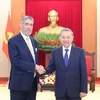35 years ago, an officer and his regiment captured the President of the US-backed Saigon regime and his key aides, becoming the witness to the event that led to Saigon’s total liberation.
Former deputy chief of Regiment 66 of Division 304 and former commander of Military Zone 1, Lieutenant General Pham Xuan The, who retired from his military career in 2008, said he still remembered every detail of what happened in the early morning of April 30, 1975--the day they took puppet President Duong Van Minh into custody, marking a magnificent victory that reunified Vietnam.
General The recalled that within the Ho Chi Minh campaign, Regiment 66 was part of a multi-division special forces group of Army Corps II, responsible for launching attacks from the east. The regiment was tasked with capturing the Independence Palace, the radio station, and the Navy Command in the heart of Saigon .
At 23:00 on April 29, all units of the Army Corps II crossed the Dong Nai bridge and advanced speedily into the inner part of Saigon . Early in the morning of April 30, they arrived at the Saigon bridge where they faced a violent fire fight launched by the Saigon regime’s troops.
After 40 minutes of fierce fighting, the tanks and motorized vehicles of the Army Corps II successfully crossed the Saigon bridge, leaving four M41 tanks and several M113 armoured cars of the Saigon troops ablaze. During the fight, Ngo Van Nho who headed tank brigade 203, and several scouts, who fought at the forefront of the battle, lost their lives.
Seizing the opportunity, The--who was then Captain and deputy chief of Regiment 66 at that time--and his soldiers, drove by jeep following a phalanx of tanks to advance directly to the Independence Palace in the heart of Saigon.
The remembered that when arriving at the Palace, the first tank attempting to ram the Palace’s main gate missed the mark, but the second tank roared promptly from behind to successfully crash the gate down and his jeep followed in its wake.
Arriving in the lobby of the Independence Palace , the general said he thought only of his duty to hoist up the flag of the liberation army above the building. It came as a complete surprise to him that President Duong Van Minh and his cabinet were actually there.
“In the lobby, I saw a crowd of western journalists at the bottom of the stairs. Running from the ground floor to the first floor, I was halted by a tall man who introduced himself as Brigade General Nguyen Huu Hanh, an aide to President Duong Van Minh. Hanh said the entire cabinet was in the conference hall and he invited me to come in to work with them,” The remembered.
The general recalled that he stopped for a while thinking of the newly-arising situation and then decided to go see the cabinet of President Duong Van Minh as invited.
After an introduction by Hanh, President Duong Van Minh came toward The and said “We know the liberation army is advancing into the inner city. We have been waiting for the liberation army so that we can hand over power to it.”
Given the new development, The thought quickly and responded promptly, “You are all captured. You must declare unconditional surrender and there is no question of handover at all.”
Knowing that his squad No. 8 had seized the Radio Station, The escorted Duong Van Minh in his jeep to the Radio Station where the Saigon regime’s President declared briefly as follows: “I, General Duong Van Minh, President of the Saigon Administration, call upon all Saigon forces to lay down their weapons and unconditionally surrender to the South Vietnam Liberation Army. I declare that the Saigon Administration, from the central down to local, are totally dissolved and the authorities from the central to local are handed over to the provisional revolutionary government of Southern Vietnam.”
The brief declaration of surrender was then aired on the radio and Saigon heard the sound of gunshots fired by the liberation army to cheer the victory –no longer to fight against the Saigon troops.
Every year on April 30, Vietnam marks this Great Victory which stands as a shining symbol of the nation’s revolutionary heroism and one of the most outstanding events of the 20th century./.
Former deputy chief of Regiment 66 of Division 304 and former commander of Military Zone 1, Lieutenant General Pham Xuan The, who retired from his military career in 2008, said he still remembered every detail of what happened in the early morning of April 30, 1975--the day they took puppet President Duong Van Minh into custody, marking a magnificent victory that reunified Vietnam.
General The recalled that within the Ho Chi Minh campaign, Regiment 66 was part of a multi-division special forces group of Army Corps II, responsible for launching attacks from the east. The regiment was tasked with capturing the Independence Palace, the radio station, and the Navy Command in the heart of Saigon .
At 23:00 on April 29, all units of the Army Corps II crossed the Dong Nai bridge and advanced speedily into the inner part of Saigon . Early in the morning of April 30, they arrived at the Saigon bridge where they faced a violent fire fight launched by the Saigon regime’s troops.
After 40 minutes of fierce fighting, the tanks and motorized vehicles of the Army Corps II successfully crossed the Saigon bridge, leaving four M41 tanks and several M113 armoured cars of the Saigon troops ablaze. During the fight, Ngo Van Nho who headed tank brigade 203, and several scouts, who fought at the forefront of the battle, lost their lives.
Seizing the opportunity, The--who was then Captain and deputy chief of Regiment 66 at that time--and his soldiers, drove by jeep following a phalanx of tanks to advance directly to the Independence Palace in the heart of Saigon.
The remembered that when arriving at the Palace, the first tank attempting to ram the Palace’s main gate missed the mark, but the second tank roared promptly from behind to successfully crash the gate down and his jeep followed in its wake.
Arriving in the lobby of the Independence Palace , the general said he thought only of his duty to hoist up the flag of the liberation army above the building. It came as a complete surprise to him that President Duong Van Minh and his cabinet were actually there.
“In the lobby, I saw a crowd of western journalists at the bottom of the stairs. Running from the ground floor to the first floor, I was halted by a tall man who introduced himself as Brigade General Nguyen Huu Hanh, an aide to President Duong Van Minh. Hanh said the entire cabinet was in the conference hall and he invited me to come in to work with them,” The remembered.
The general recalled that he stopped for a while thinking of the newly-arising situation and then decided to go see the cabinet of President Duong Van Minh as invited.
After an introduction by Hanh, President Duong Van Minh came toward The and said “We know the liberation army is advancing into the inner city. We have been waiting for the liberation army so that we can hand over power to it.”
Given the new development, The thought quickly and responded promptly, “You are all captured. You must declare unconditional surrender and there is no question of handover at all.”
Knowing that his squad No. 8 had seized the Radio Station, The escorted Duong Van Minh in his jeep to the Radio Station where the Saigon regime’s President declared briefly as follows: “I, General Duong Van Minh, President of the Saigon Administration, call upon all Saigon forces to lay down their weapons and unconditionally surrender to the South Vietnam Liberation Army. I declare that the Saigon Administration, from the central down to local, are totally dissolved and the authorities from the central to local are handed over to the provisional revolutionary government of Southern Vietnam.”
The brief declaration of surrender was then aired on the radio and Saigon heard the sound of gunshots fired by the liberation army to cheer the victory –no longer to fight against the Saigon troops.
Every year on April 30, Vietnam marks this Great Victory which stands as a shining symbol of the nation’s revolutionary heroism and one of the most outstanding events of the 20th century./.



















